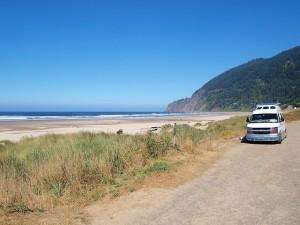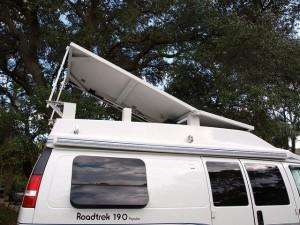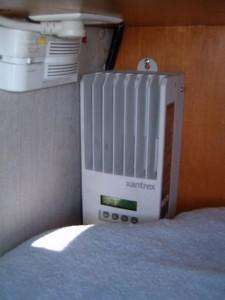Boondocking Basics: Solar Panels
 In an earlier post, I covered electrical use while unplugged – how your coach batteries store electricity for use while you're parked and enjoying the scenery in your Roadtrek. There are various ways to get electricity back into them. All RVs charge the coach batteries off the van's alternator while the van engine is running. Many also have a generator which produces 110 volt alternating current (house current or shore power) that another component, usually a converter or inverter/charger, transforms into direct current in the 13-15 volt range to replenish the batteries.
In an earlier post, I covered electrical use while unplugged – how your coach batteries store electricity for use while you're parked and enjoying the scenery in your Roadtrek. There are various ways to get electricity back into them. All RVs charge the coach batteries off the van's alternator while the van engine is running. Many also have a generator which produces 110 volt alternating current (house current or shore power) that another component, usually a converter or inverter/charger, transforms into direct current in the 13-15 volt range to replenish the batteries.
Both of these methods charge the batteries, true, but they also create noise and exhaust fumes, not particularly conducive to enjoying the wilderness experience. Generators are a convenient – and valid – target of criticism from folks who don't like RVs in their vicinity. Nobody wants to be around when a group of RVs are parked somewhere and all running their generators; it sounds and smells like a bus depot or parking garage. Big rigs can close the windows and run the A/C – I've rented beach condos smaller than some Class As. Us little rigs feel like we're hiding in a closet when we try that.
What if there were another way to get electricity back into your batteries that's silent and odorless? Solar panels are the solution to the noise/fumes problem, and increasing numbers of Roadtreks and other RVs are utilizing this power source. What I would like to do is cover some of the basics of solar panels – how they work, and what they can and can't do in keeping your batteries topped up and making electricity for you to use in your Roadtrek.

First a little dreary and hopefully brief science background on how solar panels work. An amazing amount of energy falls on the earth's surface from sunlight – about a kilowatt per square meter. A kilowatt will run a microwave – that's a bunch of power. Solar panels convert some of that energy into electricity by utilizing the ability of certain materials, silicon in the case of the panels we use, to produce an electrical current when exposed to light. Skipping over a bunch of boring details like p-n junctions and electron holes, the basic mechanism is that photons from sunlight knock electrons loose, and these electrons are collected. Flowing electrons are what we call electricity. OK, the science part is over – now wake up your neighbor and we'll proceed.
What solar panels CAN do is produce electricity directly from sunlight – no moving parts, no noise, no fumes. What they CAN'T do is capture all of it. Remember that kilowatt per square meter? Because much of that energy is the wrong wavelength to knock electrons loose in the silicon, like infrared and ultraviolet, efficiency ratings for commercially available panels struggle to get up to 20%. Most are in the mid to high teens. With limited rooftop space on a Class B, you want the most efficient panels you can put up there. A solar panel's not going to produce the 2800 watts your generator produces or the 1800 watts your alternator cranks out. Try 100 to 200 watts for a typical panel. Solar panels will produce a steady flow of power, but they aren't going to fully charge your depleted batteries in an hour like shore power or a generator.

The angle of the sunlight hitting the panels is also important. Maximum solar panel power ratings are produced with direct overhead sunlight. Us folks in the temperate latitudes don't have that. Your maximum sun elevation is 90 degrees minus how far north you are from the Tropic of Cancer – 23 degrees north. The penalty isn't significant for slight deviations from directly overhead – you'll still get 90+% of available power anywhere from 64 degrees on up, but 45 degrees is 71% power, and it goes downhill fast from there. Fortunately most of our camping is in the summer, when the sun is high in our sky. For RVs, moveable panels aren't easy to engineer. You want securely attached panels that won't blow off as you drive down the road, and also won't produce wind resistance. Almost all RV solar panel installations are flat on the roof, so the lower the sun the less power you get.

Another engineering challenge is matching the solar panel output to the batteries' charging needs. There's a basic difference in temperament between the two – solar panels' voltage increases dramatically as they get more light, whereas batteries have a threshold voltage below which they won't charge at all, and can be damaged by too high a voltage. For this reason, solar installations charging batteries use a charge controller or maximum power point tracker (MPPT) to provide marriage counseling trying to reconcile and resolve differences between the mercurial solar panels and the phlegmatic batteries. MPPTs provide an increase in efficiency by boosting low panel voltages up to where they'll charge the batteries in low light conditions, with a pickup of 30% in efficiency under certain conditions.
Most people who install solar panels also increase the size of their coach battery bank. This is because your battery bank size is your electrical equivalent of a savings account balance – you want electricity available for when you want to use it. If you watch TV in the evenings after the sun's down, you need an ample reserve of power so that you won't have to turn the set off halfway through a movie. Most people also get a larger inverter/charger to utilize the increased amount of electricity available. Solar panels, inverters, and especially batteries add weight to your RV, and reduce its cargo carrying capacity, so don't get carried away with adding components without checking the weight limits, and calculating how you'll be able to carry water, fuel and supplies while staying within your vehicle's weight limit. Solar charging systems are systems – get people who know what they're doing to install it, because voltages are high, and bad wiring is the cause of many RV fires.

Properly installed, a solar panel or two (or three) will substantively increase the functionality of your Roadtrek, especially if you like to go to remote locations for extended periods of time. I spent seven months boondocking along the Pacific Coast Highway, hanging out all day watching the waves while surfing the web and watching TV, and didn't plug in once – all our power came from the sun and occasional generator use on cloudy days. If you're familiar with oceanfront campsite prices in the commercial campgrounds along the California and Oregon coast, you'll quickly realize that solar panels greatly enhance the financial functionality of your Roadtrek as well. You can escape the cycle of generator use every 2-3 hours to recharge your batteries that makes you a bad neighbor to the day trip folks at the beach – as far as they're concerned, you're just another picnicker, except you're eating hot meals from the microwave or stovetop instead of fighting ants for soggy sandwiches like they are.
Maintenance? Compared to a generator, there isn't any. No oil changes, no generator exercising every month, no Sea-Foam to keep your float bowl from varnishing. Just keep dirt from building up on them and blocking the sunlight. A ladder and a long-handled brush two or three times a year, and you're done. With a good charge controller or MPPT, you can truly install it and forget it. Another incentive is the solar energy tax credit- Federal income tax rules allow you to deduct 30% of the cost of solar systems (panels, batteries, inverter, MPPT, wiring and installation) from your tax bill. You provide 70% of the cost – the government picks up the rest of the tab.
So consider your Roadtrek's use pattern and see if solar is an attractive option for you. If you just go out a few weekends a year and to places with electricity available, it's probably not worth it. But to escape to the wilderness or a distant lake or seashore and hang out a few days you may find it will come in handy. It's also nice to know you're doing your part for the environment, and that you're a good camping neighbor.

Have seen your name on the Roadtrek fora and decided to read your posts. Glad I did.
We have been full timing for 8 years. Started with 28′ with 400 W and AGMs. Moved to 34′ fifth wheel which has 1400 W and 9 kW-hr of LFP. We just purchased a 2002 Roadtrek 190 for travel in Canada and Mexico where the 34′ will not go (and if it does go – it may not return as almost happened in San Miguel del Allende in March). Son is in solar (first licensed solar contractor in NM) and has designed a solar system that he will be fabricating in a week once the components arrive: 415 W of solar and 360 amp-hours of LFP (12 V nominal or 4300 kW-hrs). He ran micro-wave and air conditioner to determine load and will install a 2 kW PSWI. This is sufficient for micro-wave or a/c from battery/panel combination for two hours
Really enjoyed your write up and will suggest that he look at some of your ideas: placement of MPPT (we will have to use two controllers since we will have a 315 W (45 V) and a 100 W panel (18 V)). Do like your roof mount concept that goes over the vent.
Reed and Elaine
Want to boondock!
Love to boondock!
Mr. Hammill would be very smart to hire you as a consultant, Campskunk. I could see you teaching dealer techs, rewriting the manuals, giving the presentation or two at key shows. Hey…wait a minute – maybe he has! 🙂 The bottom line – you are a gifted teacher, & a gift to all of us.
i am retired and will never have to toil for wages again, thank goodness, and besides, if jim hammill and i are going to present a cohesive public image for Roadtrek, either i’m going to have to start getting haircuts, or he’s going to have to stop 😉
Thanks for the article, Campskunk! I’ve been looking at solar for my RT for a while now, but have been trying to figure a couple of things out. I’m pretty sure the converter in my electrical box is causing problems (I get 110AC when plugged in, but no 12V charge, plus weird shorts every once in a while), and was thinking of replacing everything with an inverter/charger setup… the question I can’t seem to answer is whether I will also need a separate charge controller for any solar panels I plan to install down the road? Any help would be much appreciated!
andrew: the inverter/charger is a separate system than the solar. it makes electricity to charge the batteries from shore power. your batteries should get charging from your alternator when you’re driving, the charger part of your inverter/charger or your converter when you are plugged in, and solar if you have it. the solar controller or MPPT is separate from the other stuff – the only connection is they are all charging the same batteries. if you get solar panels they will need a charge controller or MPPT – you can’t use existing components. if you have a pre-2004 Roadtrek the converter is in a box under your fuse and breaker panel, and the newer ones they sell now are way better than the old 2-stage chargers that came on the old RTs. you can either replace the converter, or upgrade to an inverter/charger.
When I bought my RT Agile, it came with a solar package. It was installed last month. I have 3 panels on the roof and a small box that essentially tells me what is going on with the unit in one of my cabinets. I essentially, was given a small pamphlet and told to read it. I am still not sure how this all works.
Your explanation was helpful but I have to admit I still don’t understand completely what I have and how it works.
When it came back from the RV service, the battery switch was off. Now I don’t know if it should be on or off when I am not using it or when I am driving. Does it matter if the house batteries are turned on when sitting still and not in use?
I am getting ready to go out for a week of work so I have not investigated it on the internet yet. Too much preparation for work at the moment. But I still am not sure what I have but I have it.
I am going to your web site too.
There is just so much to learn.
the solar panels go straight to the battery – it doesn’t matter to them whether your battery disconnect switch is off or on. they are always connected, so they will charge your batteries when the inverter and battery disconnect switch are turned off, like for storage. use your electricity like you used it before, except there’s more of it to use.
Thank you.
Now remember, the enormous fantastic setup that the good Campskunk engineered and installed is the same as we do. Panel sizes, voltages, charge controllers, and other items will vary, as will the very difficult job of integration in the coach with all the other pieces. Also, please everybody remember,Campskunk is talking about a unit with an ONAN generator,not a engine generator, which charges very rapidly while you drive or idle. Campskunks information here is a great explanation of how solar works.
an important distinction that i didn’t make clear in the article – with the engine generator, nobody will even know you’re running it. they’ll just think you’re idling your engine. the noisy, smelly ones are Onans – basically lawn mower engines turning a 110 volt generator. expensive lawn mower engines with no pollution controls.
Thanks for another great explanation … the pieces are starting to come together. When something breaks / not working in the system, can the average dummy (me) (not talking about you! 🙂 fix it?
Cheryl:
I dunno – I put all this stuff together three years ago, and nothing has broken yet. There are no moving parts, nothing to wear out, and it’s really low low maintenance once you install it. There are displays on the MPPT and inverter remote control panel, though, that will give you error codes and other information if the system isn’t working properly, and there are troubleshooting instructions in the installation manuals, gathering dust in my cabinet.
Another great read. I feel like I now understand a little how all this solar stuff works. Thank you.
Good explanation. Makes sense of several things.
Another great article Campskunk! Can you go into more detail on the components you have and perhaps components you would use now? I have wondered how you setup all of your systems on your Roadtrek to be able to fulltime in such a relatively small space. Where you store things, how you handle water, food, refrigeration etc. We cruised Lake Superior in a 22′ C-Dory with 2 kids and every item had a place and had to do double duty if possible. We were always comfortable as long as we thought of our travels as deluxe backpacking instead of yachting hi hi. Thanks again, Bigfoot Dave
Dave:
All my components are listed in the captions of the photos on a Flickr set I made of the solar stuff. The reason I don’t go into all that stuff here on Mike’s website is that most of the audience immediately falls asleep…
http://www.flickr.com/photos/81571751@N00/sets/72157624980432608/
If I had to do it over, I’d get better panels. I got state of the art three years ago, but they went down from $500 per to $300 per, and are more efficient now. I could probably get 800 watts up there with current technology vs. the 555 I have now. I LOVE my Xantrex stuff. No complaints at all.
My unit is just a standard Roadtrek 2003 190 Popular, except I took out the third seat and substituted an armoire for dishes and pots and pans. I also took out the air conditioner and made the space into a cabinet. I put in some sliding shelves and other stuff like that, too. You can see the modifications I have made here:
http://www.flickr.com/photos/81571751@N00/sets/72157619883460601/
Water, food and refrigeration are all bog-standard Roadtrek kit; they are really well set up for this off the factory floor.
I’ve got a low voltage fridge hooked up to a panel on the roof. I went with solar because the propane ones make me uncomfortable. There’s a decent explanation here too: http://www.c4pinc.com/blog/solar-rv-refrigerator/